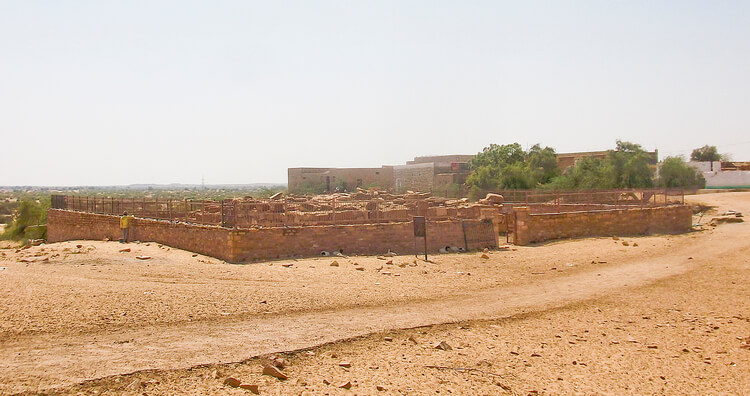
Lodruva, the ancient capital of Bhati Rajputs, formerly known as lodravapur or ludurvapatan after the Lodra Rajputs who ruled in this area before being ousted by the Bhatis, the city received severe damages once in the hand of Muhammad of Ghazni in 1025 CE and again on 1178 CE by Muhammad Ghori. The ruins and remnants of the place testify to its prosperity in the past. The most important remnants are the eleventh century Jain Temple dedicated to Parsavanatha and the ruins of Hinglajmata Temple. Torana or the ornate arch at the main entrance of the Jain temple is one of the splendid examples of the architecture. The replica of the divine tree Kalpataru is another attraction. About 200 meter northeast of this temple at Moomal-ki-Marhi there is an old Shiva temple which houses a Chaturmukha Shiva-linga of tenth century CE. Adjacent to this temple, there is another small unidentified temple showing a memorial pillar in front. Traditionally this place is also associated with the famous love story of Mahendra and Moomal, a popular folk tale of this region. Recently scientific clearance conducted by the Survey at Ludurva has brought to light remains of the ancient fortification wall along with bastions and plinth of a temple assignable to ninth-tenth century CE.
The Lodruva Jain Temple of Parshwanatha was made by Shridhara and Rajadhara, the sons of King Sagara. It's full name is Chintamani Parshwanatha temple. It was damaged several times but was renovated again and again. In 1675 VS (1618 CE) one Dhiru Shah Bhansali, the Jain Shravaka of Jaisalmer constructed a temple on the foundation of an old shrine. An icon of Saharsa-phana Chintamani Parshwanatha was installed here which was made by the artisans of Gujrat. It is of blackish colour and faded with pearls. There are four shrines on the four corners of this temple which are all with Shikharas. These were constructed by the family of Dhiru Shah during 1675-1693 VS (1618-1636 CE). The shrine is constructed of yellow Jaisalmeri stones. The pillars have beautiful carvings of flowers and leaves. The entrance is cut through two stone pillars which are joined with a torna. The Jain temple of Lodruva is a beautiful monument having garbh-griha, antarala, sabha- mandapa, bhramantika, mukha mandap and others. Its plan is definitely different from other Jain temple. The figure of Ganesha and Kubera have been engraved in the lower part of the garbh-griha. The pillars of the sabha mandapa are quite massive having ghatta- pallava motifs. The ceiling also has attractive figures. There is a beautiful Devi figure belonging to the 10th century CE. A loose figure of Ganesha having an inscription of VE 1337 (1280 CE), does not seem to form part of the temple. It seems to have been salvaged from other sites. It is also interesting that the Jains have their faith on Ganesha.
The Chunthi Ganesha also had a Siva temple belonging to the 10th century CE. It is now demolished. A loose icon of Trimukha Shiva, Maheshasura mardani and other deities are also available there. Several inscriptions of Bhatik era 534 (VE 1214) (1157 CE ) found from the place prove its antiquity.